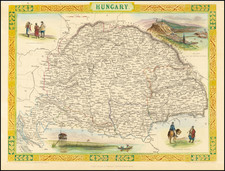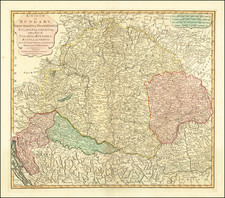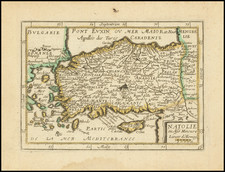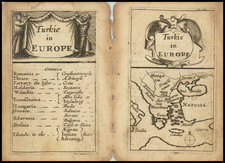Detailed map of Greece and the Balkans, with inset maps of the Dardanelles, Bosphorus Straits and Montenegro and Herzegovina.
The map provides a fascinating mid-19th Century overview of the region, highlighting topographical features, towns, roads and other details. The mid-19th century in the Balkans and Greece was a period marked by the waning influence of the Ottoman Empire and the fervent rise of national consciousness and independence movements. The complexity of this era is underscored by the intricate patchwork of emerging states, each with its own trajectory towards sovereignty and identity.
In Greece, the Kingdom was officially recognized following independence in 1832, with Otto of Bavaria instated as its first king in 1833. This period saw the consolidation of the Greek state and the pursuit of the Megali Idea, which sought to expand Greek territories to encompass all ethnic Greeks in the region. This movement was inflamed by the Cretan Revolt (1866-1869) against Ottoman rule, a significant step towards the eventual unification of Crete with Greece.
Bosnia was still under Ottoman administration, yet by the Treaty of Berlin in 1878, it was placed under the Austro-Hungarian Empire's governance, though formal annexation did not occur until 1908. The region was a melting pot of ethnicities and religions, governed by a succession of Ottoman valis (governors), with Omer Pasha Latas serving as a notable governor in the 1850s.
Serbia's autonomy had been recognized by the Ottoman Empire following the Serbian Revolution, with Miloš Obrenović I declared Prince of Serbia in 1815. He abdicated in 1839, succeeded by his sons Milan Obrenović II and then Michael Obrenović III. The latter's rule, from 1839 until his assassination in 1868, saw significant modernization efforts and the further solidification of Serbian sovereignty.
Romania's path to formation began with the unification of the principalities of Moldavia and Wallachia. In 1859, Alexandru Ioan Cuza was elected as the ruling prince of both principalities, leading to the de facto creation of modern Romania, though full independence from the Ottoman Empire was only recognized in 1878.
Bulgaria languished under direct Ottoman control until the April Uprising of 1876, which, although suppressed, set the stage for the Russo-Turkish War (1877-1878) and the subsequent Treaty of San Stefano and Berlin Congress, which granted Bulgaria autonomy under the figurehead of Alexander of Battenberg in 1879.
Moldavia, before its unification with Wallachia, was under the dual influence of the Ottoman Empire and the Russian Empire, having been occupied by Russia after the Russo-Turkish War (1806-1812). The Phanariot Greeks, as exemplified by Scarlat Callimachi, ruled as hospodars (governors) during the early 19th century.
Bessarabia, once part of Moldavia, was annexed by the Russian Empire in 1812. It experienced significant cultural change under Russian rule, including the introduction of the Cyrillic alphabet and an increase in Slavic settlers.
Montenegro was a semi-theocratic principality led by Prince-Bishops (Vladikas), with Petar II Petrović-Njegoš ruling until 1851, followed by Danilo I, who secularized the principality and established a hereditary monarchy. Montenegro's independence was recognized by the Ottoman Empire at the Treaty of Berlin in 1878.
The Dalmatian coast was under the Habsburg Monarchy, with the region administered by the Austrian Empire as part of the Kingdom of Dalmatia, established formally in 1815 during the Congress of Vienna. Herzegovina also remained under Ottoman control, though it was later merged with Bosnia under Austro-Hungarian administration following the Treaty of Berlin.
In this period, regions like Zrnagora, Dukajin, and Miredita were known for their tribal structures and resistance to Ottoman governance, often leading autonomous existences due to their geographical isolation and strong clan systems.
The historical regions of Greece, which achieved independence earlier in the century, continued to be shaped by the involvement of the Great Powers and internal developments, including the reign of King Otto (1832–1862) and his successor, King George I, who ascended to the throne in 1863.
The Arrowsmiths were a cartographic dynasty which operated from the late-eighteenth century to the mid-nineteenth. The family business was founded by Aaron Arrowsmith (1750-1823), who was renowned for carefully prepared and meticulously updated maps, globes, and charts. He created many maps that covered multiple sheets and which were massive in total size. His spare yet exacting style was recognized around the world and mapmakers from other countries, especially the young country of the United States, sought his maps and charts as exemplars for their own work.
Aaron Arrowsmith was born in County Durham in 1750. He came to London for work around 1770, where he found employment as a surveyor for the city’s mapmakers. By 1790, he had set up his own shop which specialized in general charts. Arrowsmith had five premises in his career, most of which were located on or near Soho Square, a neighborhood the led him to rub shoulders with the likes of Joseph Banks, the naturalist, and Matthew Flinders, the hydrographer.
Through his business ties and employment at the Hydrographic Office, Arrowsmith made other important relationships with Alexander Dalrymple, the Hudson’s Bay Company, and others entities. In 1810 he became Hydrographer to the Prince of Wales and, in 1820, Hydrographer to the King.
Aaron Arrowsmith died in 1823, whereby the business and title of Hydrographer to the King passed to his sons, Aaron and Samuel, and, later, his nephew, John. Aaron Jr. (1802-1854) was a founder member of the Royal Geographical Society (RGS) and left the family business in 1832; instead, he enrolled at Oxford to study to become a minister. Samuel (1805-1839) joined Aaron as a partner in the business and they traded together until Aaron left for the ministry. Samuel died at age 34 in 1839; his brother presided over his funeral. The remaining stock and copper plates were bought at auction by John Arrowsmith, their cousin.
John (1790-1873) operated his own independent business after his uncle, Aaron Arrowsmith Sr., died. After 1839, John moved into the Soho premises of his uncle and cousins. John enjoyed considerable recognition in the geography and exploration community. Like Aaron Jr., John was a founder member of the RGS and would serve as its unofficial cartographer for 43 years. Several geographical features in Australia and Canada are named after him. He carried the title Hydrographer to Queen Victoria. He died in 1873 and the majority of his stock was eventually bought by Edward Stanford, who co-founded Stanford’s map shop, which is still open in Covent Garden, London today.














![Turkey in Asia [Including Cyprus]](https://storage.googleapis.com/raremaps/img/small/98704.jpg)

